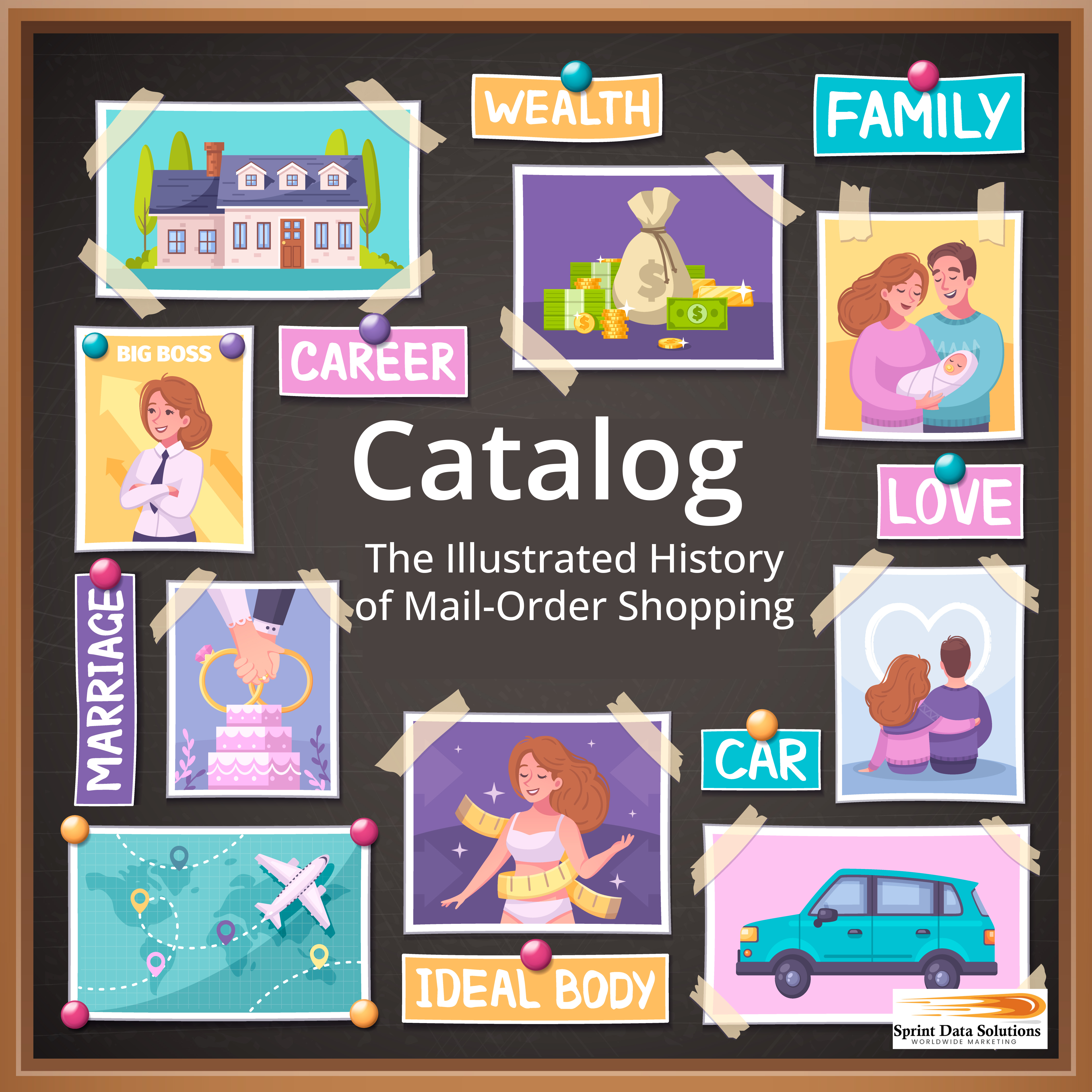Catalog & Magazine Mailing List
The 21st century has brought about significant transformations in many traditional activities, including shopping. In the past, shopping was a communal activity, often involving visits to local markets or shopping malls, where generations of Americans would interact in person to purchase goods and services. Fast forward to today, and digital shopping has revolutionized the way people make purchases, allowing consumers to browse and buy products with just a few clicks from the comfort of their homes. However, despite the rapid growth of online retail, traditional methods like catalogs still hold value. In fact, catalogs have evolved to complement digital shopping experiences, blending both tactile and digital engagement. Many businesses continue to use printed catalogs as a trusted tool for reaching consumers, offering a nostalgic touch while benefiting from the ability to combine online research with physical product browsing. This hybrid approach shows that even in the digital era, the catalog remains a relevant and impactful marketing format.
The catalog represents a nostalgic reminder of an era when print was the dominant force in the marketing world. Its legacy continues to influence modern-day marketing techniques, particularly in the form of print and digital flyers that highlight special sales prices and promotions. The catalog’s structure, with detailed product descriptions and pricing, laid the foundation for how today’s retail websites categorize and present their goods. When combined with other traditional media, such as magazines, catalogs still occupy a significant and unique niche in the marketing landscape. For businesses seeking to tap into the catalog and magazine readership market, Sprint Data Solutions Worldwide Marketing offers comprehensive support. Our expertise in data acquisition and analytics allows businesses to effectively target and reach this specific demographic, ensuring that their marketing efforts are both efficient and impactful.
The Sprint Data Solutions Worldwide Marketing Story
Sprint Data Solutions Worldwide Marketing is a fully American-owned and operated business, founded by a disabled veteran with a strong commitment to the nation’s future. After fulfilling his military duties, the founder sought to transition from defense to economic growth by establishing a business designed to support the expansion of the American business community. This vision gave rise to Sprint Data Solutions Worldwide Marketing, which began its operations in Las Vegas, Nevada. Since its inception, the company has experienced steady growth and remarkable success. Today, Sprint Data Solutions is proud to have a team with over 50 years of combined expertise in marketing, sales, and data-driven solutions, ensuring a high level of service and an unwavering commitment to helping clients achieve their business goals. This legacy of success continues to drive the company’s mission of fostering growth and providing comprehensive, innovative marketing solutions to businesses across the country.
At the outset of Sprint Data Solutions Worldwide Marketing, the marketing landscape was still predominantly traditional, dominated by analog platforms like print media and television advertising. In those early days, the company made a strategic decision to specialize in direct mail marketing, capitalizing on the effectiveness and proven success of print-based outreach. Over the years, direct mail has remained a cornerstone of Sprint Data Solutions’ services, consistently providing valuable results for clients and continuing to be an integral part of their offerings today.
As the company’s success grew, so too did its services and operational reach. What began as a localized service provider in Las Vegas, Nevada, soon expanded across the entire state. From there, Sprint Data Solutions extended its footprint to cover all 50 states, including Alaska and Hawaii. The next logical step was expansion to serve the North American markets of Mexico and Canada, further solidifying the company’s position in the continent’s marketing landscape. As the demand for global outreach grew, Sprint Data Solutions took their services beyond North America, establishing a strong presence in international markets, including the European Union with a specific focus on France. Throughout these stages of growth, direct mail continued to be the primary means of connecting with clients.
However, with the rapid rise of digital technology and the emergence of new marketing channels, Sprint Data Solutions adapted to the changing environment by incorporating digital marketing services. Recognizing the need to meet the demands of an increasingly digital world, the company embraced innovative computer-based and online marketing strategies, expanding its offerings to cover a diverse range of services for clients ready to capitalize on the growing power of digital media. This strategic shift allowed Sprint Data Solutions Worldwide Marketing to provide comprehensive, multi-channel solutions, offering clients the best of both traditional and digital marketing approaches.

The Catalog & Magazine Advantage
Despite the rise of digital technology, physical catalogs and magazines continue to hold a special appeal, often evoking a sense of nostalgia and novelty. When done right, these tangible marketing tools offer a unique experience that digital formats sometimes cannot replicate. The convenience of online ordering has certainly expanded catalog use, but it has not rendered catalogs obsolete. Instead, the digital era has enhanced their functionality, allowing consumers to browse and order with greater ease. In the past, catalogs required customers to either visit a physical store, mail in an order form, or even make a phone call to complete their purchase.
Magazines, much like catalogs, have also adapted to the digital world but retain a charm that websites often lack. When well-crafted, magazines provide a level of editorial and artistic quality that many websites struggle to match. The combination of visually striking layouts and engaging content, curated by skilled teams, often results in a more immersive experience than what can be found online. Furthermore, magazines offer a tangible, offline connection to content, requiring no internet access, which makes them accessible and enjoyable anywhere, anytime.
Catalogs and magazines, when utilized strategically, provide businesses with a unique opportunity to cut through the clutter of crowded email inboxes while offering a tangible, memorable media experience. Unlike digital marketing, these physical materials don’t require an online connection and can be easily browsed at leisure, making them an excellent way to engage consumers. Once potential customers are ready to place an order, they can seamlessly transition to a phone call or use an internet-enabled device like a smartphone or computer to complete their purchase. This versatility is especially beneficial for industries such as retail, real estate, luxury goods, and hospitality, where a high level of personal engagement is important. By combining traditional marketing methods with modern ordering capabilities, businesses can drive conversions while fostering stronger customer relationships.
Home Cooking Magazines
The pandemic brought about significant changes in consumer habits, particularly in how often people dined out. Even as restrictions ease and life returns to normal, many individuals have adopted a more cost-conscious approach, viewing cooking at home as a more economical choice for their monthly food budgets. This shift has led to a surge in interest for home-cooked meals and meal planning. Cooking magazines, with their tangible format, offer a great alternative to digital devices, which can be cumbersome and unhygienic in the kitchen. Not only do these magazines provide a curated selection of recipes, but they also serve as a reliable, easy-to-reference resource, free from the distractions and potential mess of screens. They are an invaluable tool for anyone looking to experiment with new dishes while keeping kitchen safety in mind.
Fine Wines
Wine can be much more than just a beverage—it can be a passion, a hobby, and for some, a strategic investment. Known for its sophistication, wine has a dedicated and enthusiastic following, and as a result, both wine magazines and catalogs continue to captivate the wine-loving community. These publications offer much more than a glimpse into bottles; they present an immersive experience that showcases the rich knowledge, culture, and history of wine. To truly engage wine enthusiasts, it’s not enough to simply display products; content that educates and celebrates the complexities of wine is essential.
Wine marketing spans a wide range of economic tiers, from affordable table wines designed for everyday enjoyment to premium selections from prestigious, award-winning vineyards. Specialty wines, like ice wine, are marketed as indulgent treats for special occasions, offering a unique selling point for consumers seeking to commemorate milestones. With centuries of heritage behind it, the world of wine offers a variety of approaches for magazines and catalogs—ranging from deep educational content about wine culture to up-to-date information on industry trends and emerging developments. Such diverse content ensures that wine publications cater to a wide audience, from casual drinkers to connoisseurs, with something meaningful for everyone.

Cigars
Like fine wine, cigars are often regarded as a premium luxury item, associated with refined tastes and moments of leisure. Cigars, much like wine, are an acquired taste, often enjoyed by connoisseurs who appreciate the intricate flavors and craftsmanship behind each one. Despite the medical warnings associated with their use, the passion for cigars has remained unwavering for centuries. Unlike cigarettes, cigars are typically consumed less frequently, making each experience feel more indulgent and special.
Similar to wine, cigars are consumable, which means once a current stock is used up, there’s a clear opportunity for replenishment. This opens the door for experimentation with different types of cigars, just as wine enthusiasts might explore new varieties or vintages. To effectively market cigars, proper presentation plays a vital role, including crafting compelling narratives around the distinct characteristics of each cigar. Educating potential customers about the craftsmanship, flavor profiles, and best practices for enjoying cigars can lead to increased brand loyalty and customer retention. When strategically targeted at the right demographic, cigar marketing can generate impressive results, tapping into a market that values quality, tradition, and the art of indulgence.
Household Goods
Homes depend on a wide variety of products to function seamlessly, from everyday essentials like dishwashing soap and toilet paper to seasonal items such as sidewalk salt in winter. Each room in the house requires its own set of specialized products to ensure comfort and efficiency. Catalogs are invaluable for offering a comprehensive range of products and services tailored to these needs, allowing homeowners to easily access what they require. Meanwhile, magazines serve as a helpful guide by showcasing not only the best products but also expert advice on how to use them effectively, offering tips and techniques to help maintain a smoothly running household year-round. These resources together provide both practical solutions and inspiration for keeping a home organized, functional, and well-maintained.
Children’s Products
The market for children’s products is vast and continuously growing, encompassing a wide range of categories such as educational tools, health and nutrition items, entertainment, and essential services. This market’s diversity allows for an equally broad range of catalogs that cater to different aspects of parenting and child development. However, children’s magazines offer a unique and impactful medium for introducing new products and ideas. Parents are consistently on the lookout for innovative products that can enhance their child-rearing journey. Magazines specifically targeting parents provide a trusted platform for showcasing these products, allowing businesses to directly reach an engaged audience of decision-makers eager to explore items that could benefit their children’s growth, learning, and overall well-being.
CBD Oil & CBD Creams
As states across the USA continue to update their laws surrounding cannabis, CBD, a non-intoxicating cannabis derivative, has rapidly gained recognition for its effectiveness in treating a wide range of issues, including stress, pain, and digestive problems for both humans and animals. Unlike THC, which is known for its psychoactive effects, CBD oil offers a diverse array of potential benefits, making it an attractive option for consumers seeking natural alternatives. This growing interest in CBD oil makes it an ideal product to feature in magazines and catalogs, where its versatility can be fully highlighted.
Marketing CBD oil and other CBD-based products requires a targeted approach, as consumer needs vary greatly depending on the demographic. For instance, many seniors are now turning to CBD oil as a natural solution for pain relief, an entirely different use case compared to athletes who may prefer topical CBD creams to address muscle soreness or inflammation. Tailoring your messaging and marketing strategy to meet these specific needs is key to ensuring you reach the right audience effectively, fostering trust and educating potential customers on the benefits of these products.
Sports Magazines & Products
Sports have long been the focus of dedicated magazines, which have provided fans with in-depth coverage of events, athletes, and trends within the sports world for decades. This demand for detailed, specialized content continues to grow, whether it’s a mainstream sport like basketball or a more niche area such as bobsledding. Enthusiasts are always looking for comprehensive updates, expert analysis, and insider perspectives on their favorite sports and athletes, creating an enduring market for such publications.
Similarly, the demand for sporting products remains strong, and magazines that highlight these products in detail—along with catalogs that carefully showcase the most relevant items for each sport—are always needed. The key lies in aligning the right products with the appropriate sports and targeting the correct audience of dedicated fans and participants. By focusing on specific interests, businesses can craft personalized marketing strategies that resonate with those passionate about particular sports, ensuring products reach their ideal buyers.
Seeds & Plants
Gardening has long been a cherished activity in American homes, but its significance has grown in recent years with the rising focus on sustainability and the environmental benefits of growing your own food. Many individuals are also drawn to the potential savings that homegrown produce can provide. As a result, seeds, plants, and related products have seen a surge in popularity. Whether it’s the satisfaction of cultivating food from scratch or the desire to contribute to a greener planet, gardening continues to attract a diverse range of enthusiasts.
The market for seeds and plants offers a wide variety of products tailored to different skill levels. Novices embarking on their first gardening experience can find easy-to-use kits and beginner-friendly plants, while seasoned gardeners can explore more advanced offerings, such as unique plant varieties, high-quality seeds, and specialized tools designed for specific gardening techniques. From organic gardening solutions to innovative growing systems, the possibilities are endless for consumers eager to expand their gardening knowledge and capabilities.
Collectibles
A large and diverse segment of the consumer market is passionate about collectibles, but their interests are highly specific. For example, there is a notable difference in the buying habits of a stamp collector versus a vinyl enthusiast who hunts for both new and vintage music pressings. Similarly, a “retro gamer” might focus on old video game hardware and software from the 1980s and 1990s. These groups are distinct not only in their preferences but also in how they engage with their hobbies and make purchases.
This differentiation highlights the importance of targeting marketing materials with precision. A catalog dedicated to stamp collecting would fail to capture the attention of a retro gamer, just as a publication about vintage gaming would miss the mark with a vinyl collector. However, when marketing efforts are tailored to the right audience, the response rates can be significant. Collectible marketing, when done correctly with thoughtful specificity, leads to high engagement, greater consumer interest, and more effective conversions.

Clothing & Fashion
Clothing continues to be a cornerstone of consumer purchases, both in traditional catalogs and online platforms, maintaining its status as a significant driver of retail sales. For decades, apparel has been a prominent feature in mail-order catalogs, and this trend persists today. At Sprint Data Catalog, we engage a wide range of buyers and responders who are passionate about fashion and shopping, with clothing making up a considerable portion of their purchases. However, the types of clothing that attract attention can vary widely depending on customer preferences, trends, and specific needs. Professional attire, for instance, is often valued more for its functionality, durability, and protective qualities than simply its style or trendiness.
Regardless of the type of clothing, one thing remains essential: presentation. High-quality imagery plays a critical role in making clothing items appealing to potential buyers. Catalogs and magazines that feature well-curated, visually striking photography tend to capture more attention and drive greater sales. Clothing, when showcased with compelling visuals and thoughtful content that highlights either fashion or utility, becomes a consistently strong performer in retail catalogs and marketing materials. Investing in professional photography and compelling storytelling ensures that apparel resonates with customers and remains a staple of successful catalog and magazine sales campaigns.
Home Improvement
While working with professionals often yields excellent results in home improvement and renovation projects, it’s also a substantial investment for many homeowners. This is one of the main reasons why “Do It Yourself” (DIY) home improvement continues to be a popular choice among consumers. For businesses that specialize in home improvement products or services, directly targeting DIY enthusiasts can be a highly profitable strategy—if they can effectively reach their audience.
For homeowners, there is always something that could use repair, upgrade, or even a complete renovation—whether it’s a simple fix like a leaky faucet or something more complex, like remodeling a kitchen or updating bathrooms. Many of these improvements, when done correctly, can significantly increase a home’s value. The home improvement industry offers a wide range of opportunities, from major renovations like kitchen overhauls and bathroom additions to more specialized tasks such as foundation repairs or installing energy-efficient systems. With such diversity, the market is ripe for targeted marketing efforts aimed at homeowners looking to enhance their properties. This creates a valuable opportunity for businesses to offer the right solutions at the right time, capitalizing on the ongoing demand for home improvement services and products.
Precision Marketing
The key to success in traditional print marketing, such as catalogs, magazines, or direct mail campaigns, lies in setting realistic expectations for response rates. While it is natural to aim for high engagement, a 100% response rate is unrealistic. However, businesses can significantly improve the chances of receiving a response by taking a strategic approach to targeting.
Rather than adopting a broad, indiscriminate marketing approach, businesses should focus on precision. For instance, purchasing a list of hundreds of thousands of addresses and sending out catalogs to a large, diverse group may seem like a simple strategy, but it’s unlikely to generate meaningful results. Take, for example, a catalog that features children’s products. If this catalog is mailed to a broad group that includes large numbers of single, childless individuals, like college students, the response will be disproportionately low. The target audience simply does not have the need or interest in the product being offered.
On the other hand, a more tailored approach that focuses on households with young children, particularly those with kids aged 2-10, will yield a higher response rate, even if the mailing list is smaller. Targeting 20,000 verified addresses of families with children is far more effective than sending a catalog to 100,000 college students who have no relevant interest. By focusing on the right audience, businesses can improve the efficiency of their campaigns and ensure that their resources are directed toward prospects most likely to convert. This approach emphasizes the importance of data accuracy and segmentation in maximizing response rates and achieving marketing success.
Interestingly, marketing to a smaller, more targeted audience can often yield better results than casting a wider net. For example, gaining access to a mailing list of parents with children between the ages of 2-10—regardless of whether it’s only a few thousand names—can significantly increase your response rates. This might seem counter-intuitive at first, but the reality is that reaching fewer people with a highly specific interest is far more effective than marketing to a broad audience that has little to no relevant engagement. Precision targeting ensures that your message is delivered to individuals who are more likely to respond, engage, and ultimately convert, leading to higher response rates and increased sales. By focusing on the needs and preferences of a well-defined group, you create a stronger connection, which drives better results than general outreach.
We’re Here To Help
Over the years, Sprint Data Solutions Worldwide Marketing has built an extensive database, continuously maintaining and refining it to meet the diverse needs of both consumer and B2B sectors. This dedication ensures that the data remains current, eliminating inefficiencies such as sending marketing materials to outdated or incorrect recipients, like those who may have passed away or moved. To further enhance the value of its database, the company prioritizes regularly updating its records to account for these inevitable changes, ensuring that its lists always reflect the most accurate, actionable information.
As the digital landscape has evolved, so has Sprint Data Solutions’ approach to communication. No longer are physical mailing addresses the sole means of outreach. The modern marketing world now demands a multi-channel strategy. This is why Sprint Data Solutions Worldwide Marketing embraces a range of contact details, from traditional phone numbers for voice calls to email addresses for digital campaigns and even cellular phone numbers for SMS/text messaging. By accommodating these various communication methods, the company ensures its clients can engage their target audiences through the most effective and preferred channels, increasing the chances of a successful marketing campaign.
Find The Right List For You
Whether you’re in need of a catalog and magazine buyers mailing list, a catalog shopper mailing list, or a mail-order buyer list, Sprint Data Solutions Worldwide Marketing offers the precise data you require. Our extensive categorical breakdowns are tailored to both consumer and B2B marketing needs, ensuring that you can find the right list for any type of campaign. When it comes to geographic targeting, our listings are highly flexible and scalable. You can approach your target market on a national scale, or narrow it down to a specific region, such as catalog buyers in New England. We can even drill down further, offering single-state, city, or town-level targeting. For hyper-local marketing efforts, we can provide data for specific neighborhoods, ensuring that your advertising remains focused and relevant.
In addition to geographic segmentation, we offer specialized databases built around various demographic profiles. These profiles are based on a wide range of characteristics, such as age, income level, family size, and purchasing behavior. As with all our data, these profiles are compiled with great care and continuously updated to maintain their accuracy. This commitment to data quality ensures that our contact information is always up-to-date and valuable for our clients. Sprint Data Solutions Worldwide Marketing leverages a variety of profiling characteristics, empowering you to fine-tune your targeting and optimize campaign results.
- Age
- Ethnicity
- Debt
- Age of Children
- Renter
- Homeowner
- Income
- Marital Status
- Mortgage Data
- Geography
- Veteran Status
- Big & Tall Mail Order Buyers
And countless other categories. This extensive database allows you to pinpoint your target audience with unparalleled precision, whether you’re looking for a broad reach or a very specific demographic. If you want to ensure your catalogs and magazines are reaching the most responsive and interested customers, Sprint Data Solutions Worldwide Marketing is here to assist. We specialize in providing highly targeted direct mail lists that are tailored to your unique needs. Our data-driven approach ensures your catalogs and magazines find their way into the hands of individuals who are most likely to engage with your content, boosting response rates and enhancing your marketing efforts. Let us help you create a direct mail campaign that delivers measurable results and drives success for your business.






